Latest News
Kitchen Chat and more…
Kitchen Chat and more…
Lagavulin Distillery is one of the three distilleries on Islay that made up the Kildalton trio together with Ardbeg and Laphroaig. It is a picturesque distillery situated at Lagavulin Bay enjoyed by many who visited. Saddled with a relatively dull history, Lagavulin produced one of the most widely-enjoyed whiskies on Islay.
Legal distilling started at Lagavulin in 1816 when founder John Johnston built the distillery. A second distillery, named Ardmore, originally shared the same site but the Johnston family bought it in 1825. However, by 1835, Johnston ceased production at Ardmore.
In 1836, Johnston passed away, and the family sold the distilleries to Glasgow spirit merchant, Alexander Graham. He absorbed the production of Ardmore into Lagavulin in 1837. In 1852, John Crawford Graham took over the Lagavulin distillery, but his era lasted only a brief ten years.
By 1862, James Logan Mackie & Co. bought the distillery and refurbished it. With blender James helming the distillery, the public awareness of the distillery grew. However, it was his nephew, Peter J. Mackie who took Lagavulin to greater heights.
Peter J Mackie first learned his art of whisky blending at Lagavulin at a tender age of 23. It was 1878 and his first trip to Islay to learn whisky at Lagavulin gave his invaluable experience of the production of whisky. His success with learning the secrets of distilling eventually led to his taking over of the distillery after his uncle, James Logan Mackie, died in 1889.
Peter J Mackie (later becoming Sir Peter Mackie) was an important figure in whisky history. The Mackies started to blend whisky in the mid-1880s, with Lagavulin at the core, and Peter Mackie registered the “White Horse” brand in 1891, one year after the company changed its name to Mackie & Co. Peter Mackie also co-founded Craigellachie distillery and recognised as a great innovator of his time.
Peter Mackie leased Laphroaig distillery in the 19th century and tried to copy its style. Several legal battles ensured between the two distilleries and in 1908, Peter Mackie officially lost the battle. In his irritation, he built a second distillery on the site of Lagavulin, named Malt Hill. It tried to reproduce the same characters of Laphroaig, but it failed. It closed in 1962.
Sir Peter Mackie passed away in 1924, and the company changed its name to White Horse Distillers Limited. During this period, they produced various expressions that are vastly different from the modern bottlings that we enjoyed now. One of them was a Lagavulin 16 Years. Bottled in the same style as the contemporary version, it had only one difference – the label held the name “White Horse Distillers”.
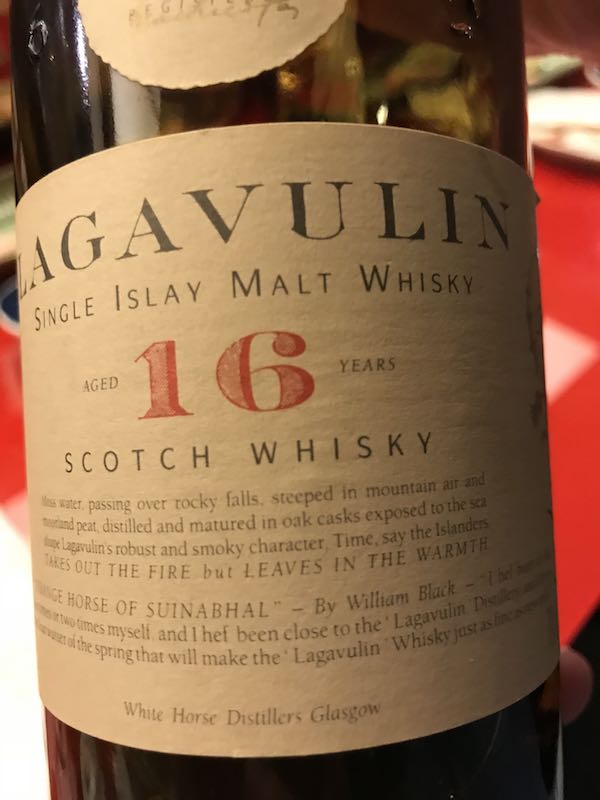
Sadly, White Horse Distillers Limited did not hold on to Lagavulin for very long. In 1927, the distillery went into the hands of DCL (present-day Diageo). When the war started, Lagavulin closed and only reopen after the war. However, tragedy struck again when a fire destroyed much of the distillery in 1951. Diageo rebuilt it.
The distillery floor malting closed in 1974 and turned into a visitor’s centre and admin offices.
As Lagavulin heads into the modern era, the Lagavulin 16 Years becomes one of the six Classic Malts. Selected in 1988, it becomes Lagavulin’s pride. Today, Lagavulin holds the fort by operating 24 hours a day, seven days a week to keep up with the ever-growing demand. The core range is the 16 Years Old and the distillery also released a limited edition cask strength 12 Years Old every year. One of the most popular at the moment is the 12 Years Old released in 2016 for the 200th anniversary of the distillery.
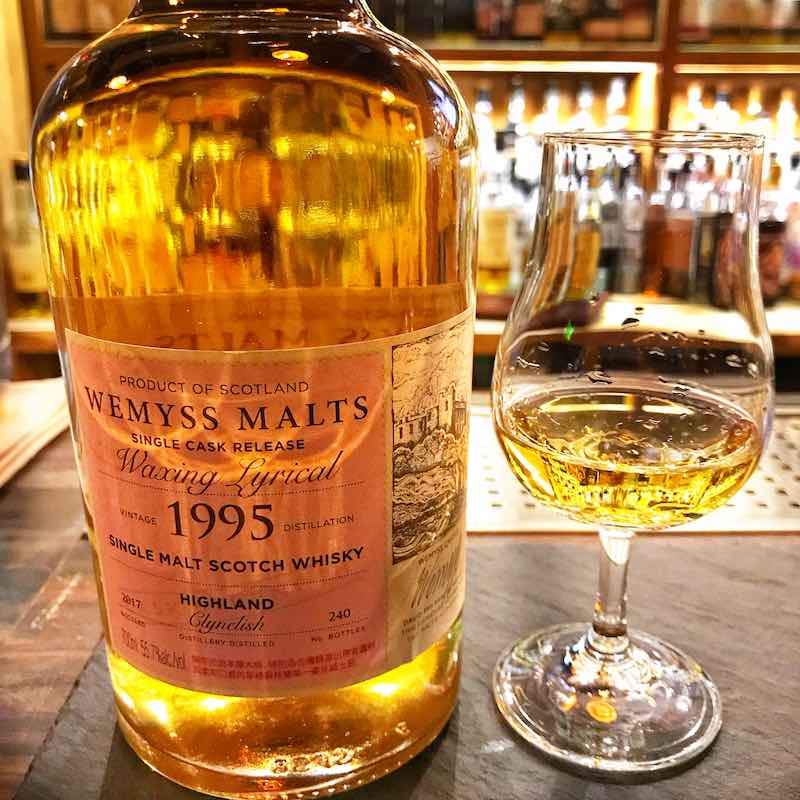
Wemyss Malts is an underrated independent bottler with some great bottles. They are not quite popular in Singapore yet, but in some countries like Taiwan, Wemyss is very well received. Flora was first introduced to Wemyss by our friend, Brendan, over at The Single Cask. Since the first tasting, we have tried more than a fair number of their expressions.
The particular expression for this review is one of those bottles which impressed us greatly. It is a 22 years old Clynelish; distilled 1995 and bottled 2017. It has an outturn of only 240 bottles. We like Clynelish well enough, but we do not usually go out of our way to try or buy a bottle. We have a couple of bottles at home, but it is not our first go-to distillery. However, after tasting this expression, we went all out to find a bottle of it to bring home with us. It was impressive.
How so? Let us find out.
Colour: Pale Gold
ABV: 55.7%
Nose: Sweet tropical fruits, red apples, sweet pears and hints of melons come quickly. As it develops, pineapples notes began to surface in the background. Vanilla cream develops and forms a beautiful nose together with the other fruity notes. Spice hides in the background, rearing its head now and then. (19/20)
Palate: Gentle spice and sweet fruits envelope the palate completely. The sweet fruity notes turn into red apples, sweet pears and butterscotch. The spice goes to the back and provides a gentle warmth all the way down the throat. (17/20)
Finish: Medium finish with a little burning spice at first but it mellows out beautifully. Sweet notes linger for a while before some oakiness takes over. (17/20)
Body: Well balanced dram that is extremely flavourful and complex. The sweetness complements beautifully with the spice and makes it an enjoyable dram to nurse after a long day. (36/40)
Total Score: 89/100
Geek Flora: “I love this Clynelish! It is fruity and yet the spice adds a challenging dimension to the dram. It encourages me to sip and savour this dram slowly, instead of drowning it out in one gulp!”
Geek Choc: “I do not like spice, especially the kind that burns! However, this Clynelish surprises me with its lovely complexity. The spice mellows quickly and is always in harmony with the sweetness of the fruits.”
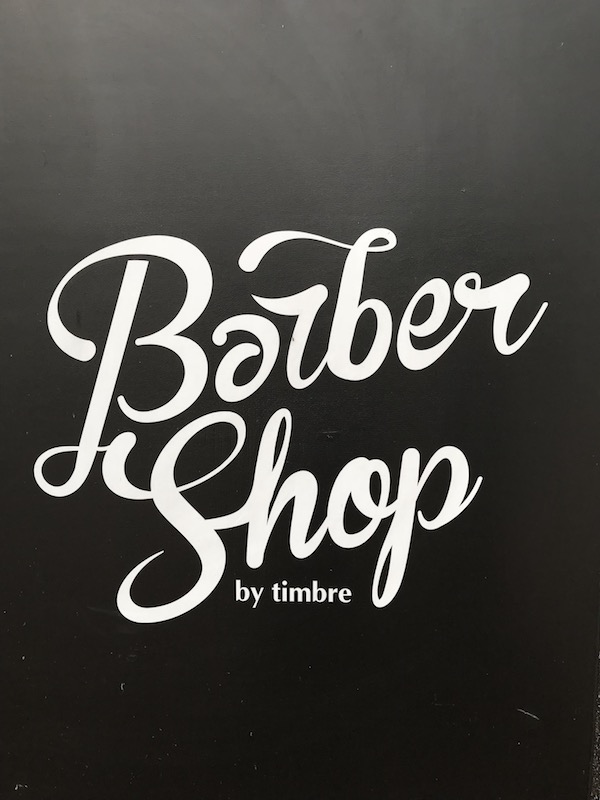
We visited Barbershop and its awesome manager, Fab Arm on an idle Thursday night after the Trump-Kim summit. We were looking for a beautiful place to chill and enjoy some live music, so, we thought – Timbre or Barbershop. Since Barbershop generally serves what we need for the night (read: whisky), we decided to head over for pizza and whisky.
It was quiet when we reached around 7-ish in the evening. Two groups of working executives occupied a couple of tables. Choc and I took the corner high table (because we like secluded spots that remind us of Sentosa the area). We took a look at their menu, and we were astounded! Not only were the prices reasonable, but the range of whiskies also expanded tremendously! Wow, we were pleasantly surprised as Fab was still working on his list the last time we came.
Before we ordered, Fab came along to say hi! We haven’t seen him for a while now, so it was a great moment to meet again and catch up finally. It was indeed Fab’s hard work that contributed to that massive and impressive list of whiskies on offer at Barbershop! We were excited to wet our lips after learning that Fab curated more whiskies from what we understood from before!

Half and Half Pizza
I was a fan of Timbre and its food, so I know exactly what we need to order. A half and half pizza to share between both of us. It was a little greedy because the pizza could feed at least three persons, but we were hungry that night. A roasted duck combined with a Yakiniku Chicken sounded like a perfect fit for two hungry and greedy persons!
Fab came along with his whiskies and rum, of course. First up, we tried a wee bit of the Speymalt Macallan 1998 (19 years). It tasted almost identical to the official bottling of the old Macallan 18 years old. The only exception is that the Speymalt is slightly more spicer than the official Macallan 18 of old. Next up, we had a wee taste of an interesting rum. Bottled by The Whisky Agency & La Maison du Whisky, it hails from Sancti Spiritus Distillery in Cuba. Exotic as it is, this rum is approachable and frisky. There was also a Linkwood 15 years old Sherry Cask by Gordon & MacPhail, but we find it too light for our liking.
We ended up with the Speymalt and the Sancti Spiritus rum as a pairing to our duck and chicken pizza. Haha…it was an innovative experience, but I thought the Yakiniku Chicken went very well with the Macallan.
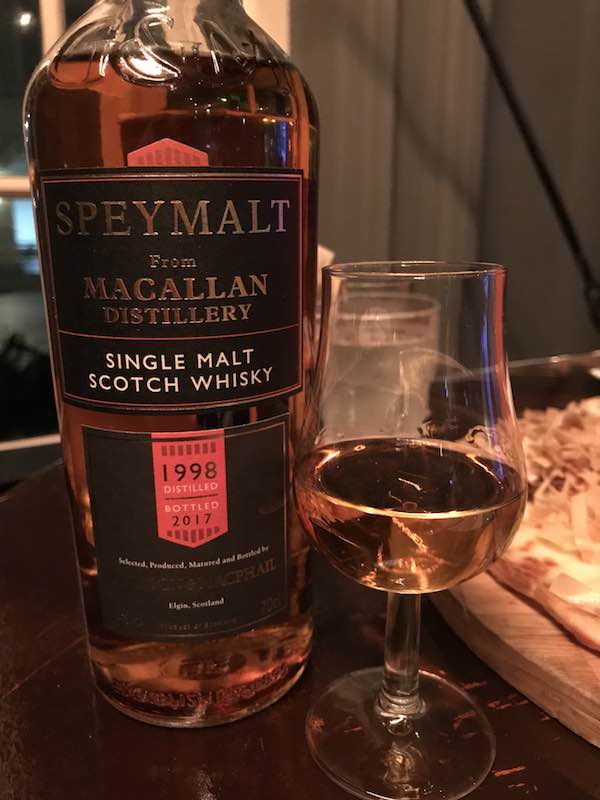
Speymalt Macallan 1998
I tried this Speymalt Macallan 1998 previously at WhiskyLive 2017 and found it to be less than desirable. Perhaps the previous bottle was aired too much, or maybe I was just not sober enough to detect the notes. However, trying this again a second time gives me a different perspective. The nose is full of dark fruits, dark chocolate, raisins and bits of oakiness. Pretty much like an old bottle of the Macallan 18 years old. The palate is dark chocolate, raisins, sultanas, woodiness and under it all, a dark fruitiness that balances the entire taste. The finish is long, with raisins and dark fruits lingering all the way.
I like Macallan in the past and love the complexity that the old bottlings offered. The modern batch appears to lack something, and I thought that it requires the love that used to go into every bottle. Perhaps I am wrong, but that’s how I feel. Therefore, I was glad to find this Speymalt Macallan. It was like an old love, reignited.
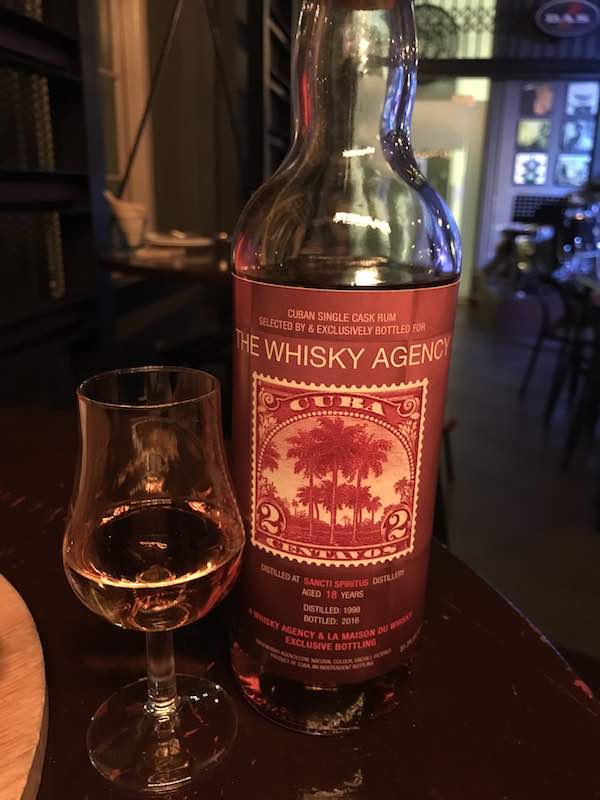
Sancti Spiritus 18 Yrs Old
Sancti Spiritus Rum is the first rum that I drank which does not turn me off immediately with its overpowering sweetness of caramel and toffee. Interestingly, the rum is full of its original character – sugar cane. The nose is full of subtle sugar cane sweetness, and a hint of strong spirit underneath the sweetness. Bottled at more than 60% abv, it is hardly surprising that the spirit within is flexing its muscles. The palate is biting, but the sugar cane sweetness covers it almost immediately. The taste mellows as I left it on my tongue. The sugar cane sweetness develops into a robust minty note as the spirit disappears, almost as if you have just eaten a mint drop. The finish gets oaky as the cask begins to talk but nothing overpowering. The mintiness lingers all the way to the end of the medium to long finish.
After all the “hard work”, we deserved yet another dram, don’t we? Once again, Fab showed his perfect hospitality with more wee tastes of another two different whiskies. First up is an Auchentoshan from Signatory Vintage. It is worthy to speak more about this whisky because it is what Auchentoshan should be when it grows up! I need to shout this off a rooftop: “Un-chillfiltered Auchentoshan is like a Rosebank!!” Yes, I am not kidding. Seriously, the Auchentoshan we had was fabulous!
The last wee taste we had was a Wilson and Morgan Bunnahabhain. Matured in a sherry cask, it is a relatively sweet Bunny! It is not fair to the Bunny though, because both Choc and I had fallen in love with the Auchentoshan.
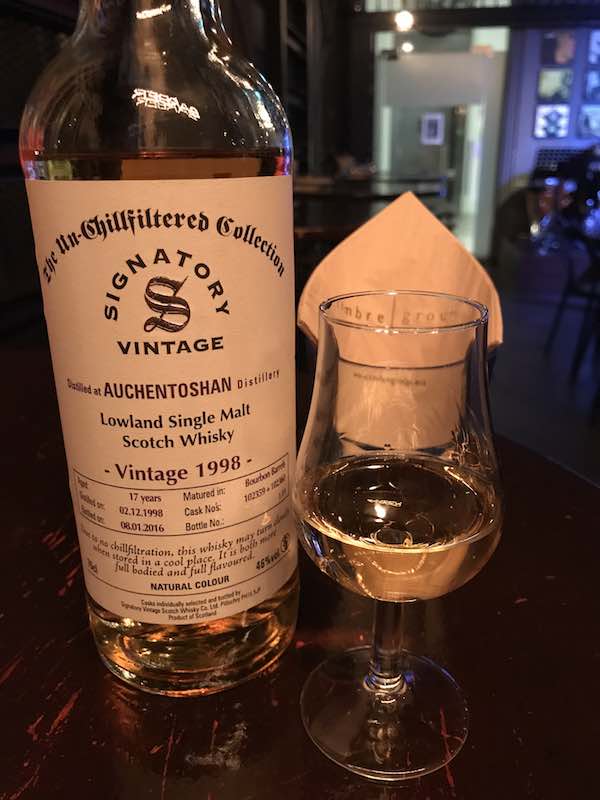
SV Auchentoshan 1998
When I first nosed this un-chillfiltered Auchentoshan, my first thoughts were, “wow, this is the full Lowland character that was lacking in the regular Auchentoshan.” As I subject the whisky to more nosing, the grassy and floral notes begin to resemble a bourbon-matured Littlemill expression that I had previously. The first taste is pure bliss as the floral notes explode in the mouth into a subtle fruity sweetness. The dry grassiness stays in the mouth even as I swallow. The finish is long and dry, with the dry grass filling the palate thoroughly.
I aired this Auchentoshan for about 15 minutes and what appeared caught me by surprise! It smells like the Rosebank 12 years old that I had at Swan Song! Omg, a second sniff confirms it. It smells like a Rosebank!! I quickly took a sip of the liquid. The palate is mellow, sweet fruitiness combined with a dry grassiness without overpowering each other. A subtle oakiness from the cask comes through at the end of the tongue, and with just a little peppery spice at the back of the throat. Again, this is similar to the Rosebank 12, but of course, the Rosebank 12 is more flavourful, and the notes are more prominent. The finish is long and dry, leaving me wanting more.
We got to admit that we called it a night after the Auchentoshan 1998 because we wanted to savour the flavours for as long as we want. Besides, each pour at Barbershop is 40ml, and we already had 160ml between us. Time to call it quits when we were still alert and sober!
Naturally, the best dram of the night was the Rosebank 12 Auchentoshan 1998! I think my life is quite complete now because I finally know how un-chillfiltered Auchentoshan taste like. My guess is right – it showcases all the right Lowland characters at its natural best.
Thank you, Fab, for showing us how Auchentoshan can shine! For those of you who want to visit Barbershop, give Fab a shoutout when you go, and he will treat you well!
11311 Harry Hines Blvd
Dallas, TX, United States
(555) 389 976
dallas@enfold-restaurant.com
